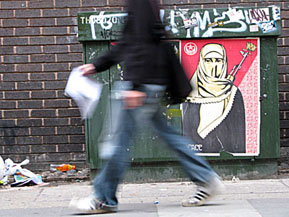Article on Why No One Style of Art Is Better
Is Graffiti Fine art?
CFA prof on Fairey, Banksy, and where to draw the line

When street artist Shepard Fairey was arrested on two outstanding warrants for holding defacement final month — incidentally, on the fashion to the start museum exhibition of his career, at Boston's Institute for Contemporary Fine art — a representative of the Boston Police likened his work to graffiti.
But Fairey, who rose to prominence when his Obama Hope affiche was featured in last year'due south presidential race, has since pleaded not guilty to the charges, describing his piece of work as "graphic art with social and political messages."
The arrest, Fairey's 15th, has provided new fodder for the long-standing debate virtually what is art and what is property defacement. Should Fairey be punished, or should he exist celebrated?
BU Today asked Hugh O'Donnell, a Higher of Fine Arts professor of painting, who teaches CFA'south Site-Specific Fine art form, to counterbalance in on the discussion.
BU Today: When does graffiti become art?
O'Donnell: Graffiti is literally the writing on the wall — the voice of those who cannot discover whatsoever other way to publish their thoughts anonymously. The term is used to describe a public visual expression that has not been sanctioned by a commissioning authorisation, something that is placed in public view, unsolicited and without permission. Today, all the same, it'southward no longer anonymous, but instead an esoteric form of cocky-publicity that seeks the widest audience possible.
Graffiti can be art. Art is what we telephone call something when it carries significant human symbolic expression. It's all a question of degree, and there is practiced art, great art, and bad art.
 Is graffiti art any more or less evocative than other forms?
Is graffiti art any more or less evocative than other forms?
The freedom of graffiti, its ability to be anywhere and everywhere, and the sometimes daredevil places information technology is made requite it a romantic edge and powerful exposure. Today, communications media have exploded and the whole issue of distribution of intellectual holding has become as big for art as information technology is for scientific or medical inquiry. Distribution of music has become revolutionized, simply visual art lags backside in getting free of the gallery and museum, which are the traditional ways of controlling and providing access to the public.
But why should the hype be reserved for the selected few, with dealers, curators, and critics ruling the distribution of ideas? The graffiti movement is utilizing the public to spread its ideas. It's the survival of the fittest — and at that place are downsides, because art now has to survive in the aforementioned loonshit every bit advertizing campaigns, and sometimes information technology just suffers from the speed at which information technology is getting washed every bit well every bit from the repetitive activity of branding a recognizable image over and over again. All the same, Andy Warhol legitimized this as art dorsum in the 1960s. In many minds, the idea of success even for art is that it communicates finer fifty-fifty when it is little more than simplistic branding.
When the police arrest a street artist like Fairey, is it censorship? Does media attention assistance the bulletin reach a broader audience?
Shepard Fairey probably embraces the fact that he gets arrested because it gives him the kind of prime number-time exposure that he craves. If the police wanted to curb the glamour of his notoriety, they should arrest him only when he is actually in the act of making graffiti. The ICA exhibition is not graffiti.
Why do street artists like Fairey, or Banksy, in England, have huge, devoted followings?
When yous are known to a lot of people, you are a celebrity, and our civilisation worships celebrities. When Banksy had his work collected by Brad Pitt and Angelina Jolie, it fabricated him a world-class phenomenon. He was able to make his photographic documentary edition of work the number-one book in England.
Street artists are often making social commentary — does getting arrested sometimes strengthen their point?
It strengthens their authorisation rather than their points. Often the point is rather glib and merely noticeable because of notoriety. Being notorious is, I would say, an essential ambition for the graffiti writer.
What would you propose as a legal solution to this problem?
If someone put graffiti on my wall and it was bad art, I would want them arrested and made to restore the wall. More sites that are legal should be encouraged, with a percent for art made available by the owner of the space in the aforementioned way that new buildings in some states give a percent for art every bit a mandatory requirement. The owner needs to exist a collaborator. With this programme, at that place would be no stop of space to choose from.
What advice would y'all offering a student thinking virtually pursuing street art equally a career?
I'd inquire them to bank check out the Graffiti Research Lab for clues about ways to make public statements that do minimal damage to public property.
Edward A. Brownish can exist reached at ebrown@bu.edu.
Explore Related Topics:
hernandezevervall.blogspot.com
Source: https://www.bu.edu/articles/2009/is-graffiti-art
0 Response to "Article on Why No One Style of Art Is Better"
Post a Comment